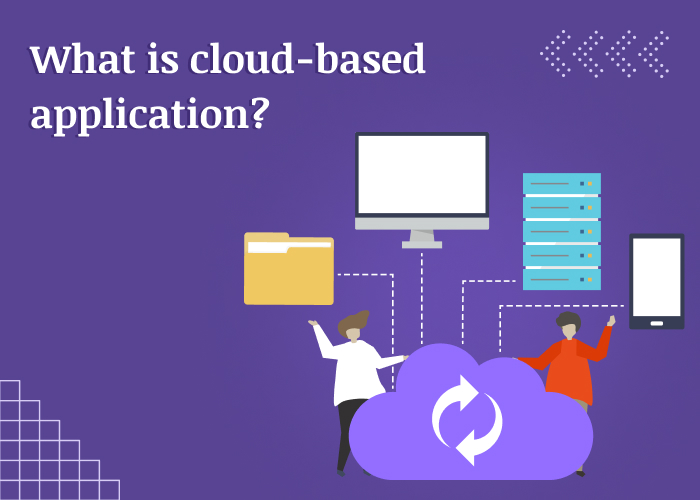What is cloud-based application?

Cloud systems like Amazon Web Services (AWS), Microsoft Azure, Google Cloud Platform (GCP), and others are intended to be fully utilized by these apps. Cloud-native architectures and technologies, including distributed databases, serverless computing, microservices, and containers, are frequently used in their development.
How to develop cloud-based applications?
- Define Requirements: Provide the goals and specifications to the cloud-based application development company. Recognize the intended feature set, target market, scalability needs, and any compliance or regulatory issues.
- Choose Cloud Platform: Choose the cloud platform that most closely matches your needs and tastes. Among the well-liked choices are Google Cloud Platform (GCP), Microsoft Azure, Amazon Web Services (AWS), and others. Take into account factors like cost, services provided, availability by region, and integration potential.
- Architectural Design: Consider security, dependability, and scalability while designing the application’s architecture. Take into account utilizing serverless computing, distributed databases, microservices, containers, and other cloud-native architectures.
- Select Development Tools: Based on the cloud platform and programming languages of your choice, select the relevant development tools and frameworks. For instance, AWS provides SDKs for a number of programming languages, including Java, Python, and Node.js, in addition to infrastructure as code tools like AWS CloudFormation.
- Develop Application Code: Craft the application code in compliance with the specified architecture and prerequisites.
- Implement Security Measures: Implement security best practices to protect the application and data from unauthorized access, data breaches, and other security threats.
- Quality Assurance: Make sure that the application is reliable, performant, and functional by thoroughly testing it. Employ testing frameworks and tools that operate in cloud systems to replicate various usage situations and spot any problems.
- Deployment: During deployment, make sure that the networking, security, and resource configurations are done correctly.
- Maintenance: Set up monitoring and logging solutions to track application performance, detect errors, and troubleshoot issues in real-time. Implement a maintenance plan to keep the application updated, secure, and compliant with evolving requirements.
What are the benefits of cloud-based application development?
- Time-saving: IT departments have significant time-savings compared to on-site servers because the cloud provider would check on updates and the IT team can work on other important tasks.
- Cost-effective: Another benefit of cloud-based application development is that it cuts the costs of on-site server installation and maintenance. As the cloud provider handles maintenance and it is easy to set up the cloud, it becomes cost-effective.
- Easy to Deploy: In some cases, you can automate the deployment process.
- Recovery: Investing in a separate server room and the necessary technologies to copy information and restore systems is necessary to enable excellent disaster recovery with conventional applications. Cloud services manage this for hosted programs, eliminating the need for additional infrastructure expenditures. Your data will be safely kept online even if your device or a server sustains physical damage.
- The ability to scale: The building of applications on the cloud guarantees simple scalability. In contrast to the traditional paradigm, which necessitates extensive preparation for things like servers, hardware, and app functionality, cloud-based applications allow you to easily expand any component of your application without worrying about hardware. You may scale your server, for instance, by adding new servers.
- Flexibility: Cloud-based application development is frequently more adaptable than those that do not. For instance, the cloud service provider will attend to your demands and take care of all infrastructure-related problems if you need to make modifications to the IT infrastructure.
Conclusion
To sum it up, cloud-based application development has several advantages that are changing the software engineering field. The benefits of cloud-native apps are clear in many sectors, ranging from increased scalability and flexibility to cost-effectiveness and streamlined deployment procedures. In today’s fast-paced digital economy, organizations may increase operational efficiency, accelerate innovation, and offer improved user experiences by embracing cloud-native designs and employing cloud computing infrastructure.
FAQs
What security factors should be taken into account while developing cloud-based applications?
What effects does scalability have while developing cloud-based applications?
What financial ramifications come with developing cloud-based applications?
In what ways does cloud-based application development support remote work and collaboration?
Which are the best ways to keep an eye on and manage cloud-based applications?
Ravi Bhojani is the Chief Marketing Officer (CMO) at Alian Software, where he spearheads the company’s marketing strategies and drives its brand presence in the competitive IT services landscape. With over a decade of experience in the technology and marketing sectors, Ravi has consistently demonstrated his ability to blend innovative marketing techniques with deep industry knowledge to deliver outstanding results.